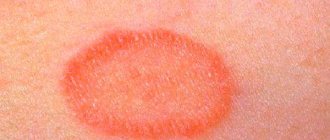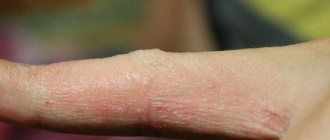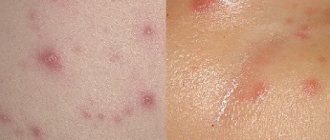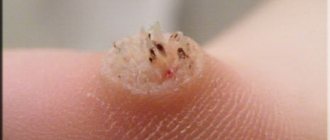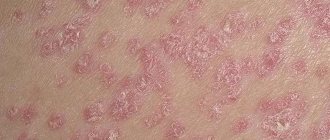What is rubella
Rubella is a highly contagious acute infectious disease. It can be acquired (through the air during a conversation, close contact with an infected person) and congenital (during pregnancy from mother to fetus).
Infection occurs especially often in unvaccinated children aged 2 to 9 years. Most children under 6 months of age have innate immunity to the disease, so cases of rubella at this age are very rare. When intrauterine infection with rubella occurs, a child sheds the infection for one and a half to two years, and sometimes 2.5 years.
Complications from acquired rubella are rare in children with immunodeficiency. With congenital diseases, children are born with developmental disabilities.
Important! The causes of rubella are the high contact rate of the disease. The disease affects a person who is not infected or has not previously encountered the disease in 90% of cases.
Causes of the disease
Rubella is caused by a virus that most often enters your body when you cough or talk to someone who is infected. The disease may not appear immediately; the incubation period is from ten to twenty-five days.
The virus is so viable that it can survive even in the most unfavorable environment. In addition, its molecule is very quickly absorbed into the human blood and can remain in the body from a week before the rash and about two after the pimples disappear.
The rubella virus is killed by the influence of certain substances. What influences it?
- Disinfectants;
- Ultraviolet;
- Formalin;
- Alkalis and acids;
- Ethers.
You can become infected with this disease in closed places with large crowds of people, especially in kindergartens and schools. The first signs may appear as early as 8 hours after infection. If the child’s immunity is normal, then rubella leaves almost no complications and is of moderate severity. But infection during pregnancy can lead to serious consequences for the fetus.
In the early stages of pregnancy, doctors observe the development of defects in 60 percent of babies, but the more weeks, the percentage decreases. For example, at 20 weeks, developmental abnormalities due to rubella infection are observed in only 7 percent of infants.
How does the disease progress and how does infection occur?
Rubella, like any disease, has its own characteristics. The initial stage of development of the disease may not manifest itself in any way and an apparently “healthy” child is already a carrier of the disease and infects other children. Between the incubation period and the period of rash there is (although not always) a prodromal period. It is characterized by general weakness, fever up to 38 degrees, and enlarged lymph nodes. Next comes the period of rashes.
Features of the disease and its symptoms:
- A person becomes contagious during the incubation period of the disease, which lasts about 2-3 weeks, 7 days before the rash appears on the body, and remains contagious for another 7-10 days after its onset.
- Children who are constantly in contact with their peers, talk, share toys, and have poor hygiene are more often susceptible to the disease.
- The mucous membrane of the respiratory system is the conductor of the virus into the body, then it flows with the blood throughout the body, leading to enlargement of the lymph nodes. Sometimes the disease is accompanied by the following symptoms: mild rhinitis, dry cough, throat discomfort, conjunctivitis, temperature 38 degrees. In adults, the disease is more severe, with headaches, refusal to eat, and muscle pain.
- On the first day of illness, a rash appears on the body in a shape resembling circles or ovals of pink-red color. Most often, it appears first on the face, neck, behind the ears, on the back of the head, then, within a day, it covers the area of the back, buttocks, arms and legs, without affecting the feet and palms. When the disease is already reflected by a rash on the body, its presence can be detected in feces and urine.
- The rash lasts 2-4 days.
The rubella virus usually does not spread in the summer, as it is killed by exposure to ultraviolet radiation and direct sunlight. The main surge of the disease occurs in the winter months and the beginning of spring.
Attention! The disease is epidemiological in nature, with a high incidence rate observed every 5-9 years. Epidemic periods are characterized by a high level of congenital rubella diseases. You can read the symptoms of rubella in children in our article.
Rubella symptoms
The symptoms of rubella are pronounced and appear quickly. The rubella virus enters the body through the mucous membranes of the respiratory system and spreads throughout the body, causing swollen lymph nodes, especially in the back of the head and on the back of the neck. The incubation period is 1-2 weeks, which means that an infected person is dangerous to others during this period. The child may have a slight runny nose and dry cough, sore throat, watery eyes, and a slight rise in temperature.
What does rubella look like? On the first day of the disease, almost every patient experiences a skin rash; a more pronounced rash occurs in children. The rash appears as small spots, round or oval in shape, pinkish or red in color. The rash first appears on the face and neck, behind the ears and on the scalp; after a day it spreads throughout the body, arms and legs. The rashes are especially pronounced on the back, the outer surface of the arms, on the buttocks, and on the outer surface of the legs. No rashes appear on the palms and soles. In rare cases, a small rash may appear in the oral mucosa. Rashes in a child go away after 2-3 days; in an adult they can last longer.
Some people confuse rubella with chickenpox. Chickenpox rashes are large and watery, causing severe itching. Rubella can be detected by pressing a finger on a spot of the rash: it disappears and then reappears. The rash does not bother a person and does not cause pain. Rubella is often mistaken for a common cold, but this is easy to check, since the rubella virus is not affected by antipyretic drugs and signs of the disease remain. At the first symptoms, you should consult a therapist.
The question of how one can distinguish a disease such as rubella from an allergic reaction is very popular among patients. First of all, a signal that a child or an adult has rubella is the gradual appearance of rashes on the skin and their rapid disappearance. In case of an allergic reaction, as a rule, the person is covered immediately and such skin damage takes a long time to resolve.
The second cycle of a disease such as rubella is also characterized by other symptoms. For example, the specific symptoms of this disease include a significant increase in lymph nodes in the back of the head, as well as submandibular and cervical lymph nodes. This and the presence of general infectious symptoms, in turn, are additional confirmation that rubella is developing in the patient’s body.
In adults, rubella causes more acute symptoms. The skin rash remains for five days. The spots on the skin do not appear separately, like in a child, but can merge into large spots. At the same time, body temperature rises greatly, sometimes reaching 40 degrees. Severe headaches and migraines, fatigue and weakness in joints and muscles occur, and appetite decreases. Due to severe lacrimation, an adult often experiences conjunctivitis, accompanied by photophobia and redness of the eyes. In addition to the main symptoms, a man experiences discomfort and pain in the testicular area.
Diagnostics
Primary diagnosis of the disease is carried out by assessing the epidemiological status of the locality and cases of the disease occurring in a school or kindergarten. When examining a child, the doctor may notice rashes on the mucous membrane (upper palate, larynx, pharynx), which sometimes precede the appearance of a rash on the body. The doctor also feels the occipital area of the head and neck to detect inflamed lymph nodes.
If it is difficult to make a diagnosis or to confirm it, a blood test is prescribed to determine the presence of antibodies to the virus. With rubella they increase 4 times or more. Repeated analysis is carried out after treatment procedures. Additionally, the following may be prescribed: urine analysis, ECG (to exclude possible complications), chest x-ray (if complications such as pneumonia are suspected).
Remember! Do not try to diagnose your child's illness yourself. Even a doctor cannot always identify a disease at first glance. Contact a medical facility where the child can undergo all the necessary tests.
Course of the disease
Rubella is easy. The incubation period lasts from 14 to 21 days, after which a prodromal period begins, lasting from 1 to 5 days, as a result of which fever, malaise, and lymphadenopathy may occur. Swelling and tenderness of the occipital, postauricular, and posterior cervical lymph nodes are also manifested.
When a rubella rash appears, which is very similar to the measles rash, but goes away faster and spreads less. When spots appear on the face, the rash quickly spreads to the patient’s body and is observed for 3 to 5 days.
What danger does rubella pose to infants?
Rubella in children under one year of age is extremely rare. This is explained by the fact that during pregnancy, the mother passes on to the unborn baby a portion of antibodies to various types of infections that she herself has suffered from or from which she has been vaccinated. They should be enough to protect the fragile child’s body for the period until it develops its immune system.
If a woman had no contact with this disease before pregnancy, the child will not receive protective antibodies from her. In children, the disease develops rapidly and can provoke severe convulsions. Children under one year of age require immediate hospitalization in the infectious diseases department of the hospital. There is a high risk of developing meningitis and encephalitis.
It is important to know! If a child has had the disease before one year of age, he or she develops stable immunity to rubella for life, and there is no need for routine vaccinations.
What kind of disease is this
Rubella is an infectious disease. Most often, it affects children 2-10 years old who have not been vaccinated. Adults may also be at risk if they lack immunity to the disease.
Did you know? With mother's milk, the child receives substances that contribute to the formation of immunity. It helps protect the baby from many diseases in the first year of life.
Periodically, every 5-7 years, outbreaks of this disease occur. This occurs mainly in spring or summer. It is easier for residents of large cities who constantly visit crowded places to become infected.
Consequences
Usually the disease in children is mild. Consequences from a previous illness are possible if the child’s immunity was weakened, or at the time of the illness another one was added to it. The disease is more difficult for unvaccinated children to tolerate.
Possible complications:
- angina;
- pneumonia;
- thrombocytopenic purpura (a decrease in the number of platelets in the blood is characterized by frequent bleeding, local hemorrhages on the skin);
- meningoencephalitis;
- rubella encephalitis (inflammation of the membranes of the brain). The child recovers and is registered with a neurologist and infectious disease specialist for another 2 years (or maybe more). There is a possibility of death;
- otitis;
- arthritis.
Congenital pathology has the following consequences:
- thrombocytopenic purpura;
- pneumonia;
- developmental delays;
- deafness;
- bone damage;
- diabetes;
- encephalitis;
- hepatolienal syndrome (enlarged liver and spleen);
- malformations of the eyes, heart defects.
Remember! If the disease is severe or causes complications, the child needs immediate hospitalization.
Treatment of rubella
Specific therapy for rubella has not been developed. In childhood, it occurs relatively easily, especially in a previously vaccinated child. Activities are aimed at alleviating the patient’s symptoms and general condition. It is prohibited to visit educational institutions for 21 days; sick leave is issued to the child and parent for the duration of quarantine.
What to do:
- Provide the patient with bed rest for seven days after detection of the disease.
- Avoid psychological and physical stress to prevent complications.
- Limit the function of the visual organs (reading, watching TV, video games).
- Maintain a drinking regime (at least two liters of liquid per day), you can use still mineral water, as well as a saline solution like “Regidron”.
- It is imperative to maintain the proper level of hygiene, constantly change underwear and bed linen, ventilate the room and do wet cleaning.
- A gentle diet should include plenty of protein and dairy products. Cooking dishes mainly by steaming or boiling. Meals should be small and frequent (up to five to six times a day).
- Fresh and canned berries and fruits are good for general strengthening of the body. Compotes and vitamin decoctions must be taken at a comfortable temperature.
- The attending physician prescribes antispasmodic and painkillers, as well as antipyretic drugs.
- For sore throat, gargles or topical sprays will help, depending on the age of the patient.
- If there is severe nasal congestion or swelling, the doctor will prescribe antihistamines.
- Treatment with antibiotics is carried out only when rubella is complicated by a secondary infection (sore throat, bronchitis or meningitis).
The disease is most difficult in children in the first year of life. With congenital rubella, when infection occurred in the prenatal period, hospitalization and the use of special antiviral drugs may be necessary. Children under six months of age have innate immunity, so they are less likely to suffer from such diseases, but when infected, rubella up to one year of age is much more complicated, with clear clinical and intoxication symptoms.
Treatment
In most cases, treatment is carried out at home. First, parents need to prepare a separate, well-ventilated room for the child. For a week, it is necessary to provide the child with bed rest, proper nutrition and drinking regime.
Rubella itself is not treated, only the symptoms of the disease are eliminated.
Drugs for treatment:
- antihistamines are prescribed for rashes (Tavegil, Suprastin, Claritin);
- antibiotics are prescribed for complications, for example, pneumonia or sore throat (Wobenzym stimulates the immune system, relieves inflammation);
- for conjunctivitis, a solution of albucid is prescribed;
- antipyretics are prescribed only at temperatures above 38 degrees.
Remember! Medicines can only be used with the permission of a doctor, and strictly in accordance with the instructions.
Folk remedies
Homeopathy effectively eliminates the symptoms of the disease.
Recipe No. 1
One tablespoon of a mixture of birch buds, string grass, wormwood, yarrow, clover flowers, and dandelion roots is poured with 500 ml of boiling water. It is infused for about half an hour, filtered and given to the child no more than 4 times a day, 1/3 cup.
Recipe No. 2
1 tbsp. l. Rose hips and black currants are poured into 400 ml of boiling water, left for 45 minutes, filtered, and taken a little at a time throughout the day.
Recipe No. 3
Raspberries, lingonberries, linden flowers, coltsfoot leaves (1 tbsp each) are mixed, then 2 tbsp. l. pour 500 ml of boiled water. The mixture is infused for a quarter of an hour, the child is given half a glass before bedtime.
Rubella in children
Rubella is a fairly common disease in childhood, but adults can also get it. The etiology (origin) of the disease is infectious. Since rubella is an anthroponotic disease, the infection can only be acquired from a person who is a carrier of the disease or from an already ill individual.
Rubella was noted by doctors back in the sixteenth century, but then it was too early to talk about any specific research in the field of treatment of this disease - the Middle Ages were too “dark” at that time. For the first time in the literature, a description was found by the French physician de Bayu, then by the German F. Hofmann, which, unfortunately, did not encourage scientists to further research. Only a hundred years later rubella began to be studied as an independent disease.
In 1881, the disease was isolated separately, and Japanese scientists proved its epidemic nature and “contagiousness.” Already in the twentieth century, the connection between rubella and the problem of fetal development, pregnancy and childbirth was proven. Today, medicine has enough knowledge to stop outbreaks of the disease in a timely manner, but rubella during pregnancy is still a significant threat to the life and health of the fetus.
Development of the pathological process
The virus usually enters through the mucous membrane of the respiratory tract. It is spread throughout the body by blood flow, that is, by hematogenous route. At the same time, it has properties to influence the skin and lymph nodes. Usually, at the end of the latent period, the virus can be isolated in the nasopharyngeal mucosa, and at the first appearance of symptoms it disappears. After seven days, the blood serum produces protective antibodies against the virus, and then their number increases. Rubella rashes noticeably decrease by the end of the week, but the lymph nodes can remain in this state for up to one month.
Symptoms and signs of rubella
The main manifestation of rubella is generalized lymphadenopathy, that is, enlargement of the lymph nodes in several (more than two) places that are not located with each other. This indicates that the infection has penetrated the lymph and is manifesting itself elsewhere. Another external manifestation by which medical workers suspect rubella is a skin rash. Rubella usually gives fever. In some cases, rubella causes headache and muscle pain.
- The rash first appears in patches, mostly on the face and neck area. After a few hours, it moves to other parts of the body - the folds of the arms, near the buttocks, and on the back. Externally, the rashes appear as small spots the size of a lentil grain, which are scattered in the affected area. They do not merge with each other and have a clear shape (oval or round). The rash itself quickly goes away - after three days the rash itself is almost invisible, only a hyperemic area (redness) remains in the place where it was. There is no itching or peeling observed.
- Temperature. Fever with rubella is common, but not necessary. Some children do not have hyperthermia at all, and some have low-grade fever (from thirty-seven to thirty-eight). Sometimes an increase to thirty-nine or higher is possible.
- Lymph nodes. With rubella, the lymph nodes are noticeably enlarged - in a short period they increase in size to the size of large beans and are visible even to the naked eye as tubercles on the surface of the skin. Most often, the lymph nodes in the neck and back of the head are affected - they become painful when pressed, dense, like pebbles. Usually these places are somewhat hotter than the rest of the body surface (the phenomenon of regional (local) hyperthermia).
Most often, rubella affects children from one to seven years of age. Newborns and infants receive temporary immunity from the mother, which becomes significantly weaker after a year. If a child has had rubella once, then after the illness an immunity is formed that will protect him for the rest of his life. Recently, doctors have reported that the disease rubella is increasingly being reported in adolescents and young adults. If the symptoms and signs of the disease manifest themselves as an epidemic (in a community, in a region), then diagnosing the disease will not be difficult. If sporadic rubella is detected (for example, if a person is infected in one region, and manifestations are noticed in another, and the epidemic environment is free), doctors usually collect a more thorough medical history and prescribe additional tests. Most often this is a blood reaction to inhibition of hemagglutination. Thanks to this test, it is possible to identify the infection and begin treatment on time.
Causes of rubella
Typically, the infection becomes active in the spring or autumn and is transmitted by airborne droplets. The time during which the infection does not manifest itself externally is up to two weeks. During this period, you can infect another person without knowing about your condition. Due to the fact that children go to a peer group (kindergarten) from approximately three years of age, this period is the most dangerous for the child’s body. The course of the disease in children is much easier than in adults, especially if all instructions for treating the disease are followed.
Differential diagnosis
If you notice the first signs of rubella, you should immediately call a doctor. No matter how others insist that this disease does not require treatment and that it is easy to recognize, it is nevertheless necessary to carry out competent differential diagnosis in order to distinguish the disease from other diseases and begin proper treatment. In this case, a mandatory medical consultation will be required, especially if the symptoms of rubella are not very pronounced, are erased, and another disease is present that may confuse the clinical picture.
First of all, rubella should be distinguished from measles . So, with measles, unlike rubella, a febrile state, elevated temperature and a state of intoxication are observed. With measles, the rashes are located in groups, merging into large papules - with rubella this is not the case.
Scarlet fever also has a number of specific symptoms . Firstly, scarlet fever rashes are smaller in size; they occur against the background of light, healthy skin.
Allergies are usually marked by the presence of or exposure to an allergen . If parents know about the allergen, then it is not difficult to imagine such a situation. Allergy rashes vary in shape, have fuzzy edges, and can increase in shape and color if children scratch them when itching. Most often, when taking antihistamines, the allergic rash goes away quickly. The absence of temperature in allergies is of greater importance in diagnosis.
With exanthema, the rash appears a second time after the temperature subsides . The main difference from rubella is that the rash is located mainly on the body, almost not affecting the face.
Treatment of rubella
The disease can be treated at home, and the need for specialized medical care appears only with complications of rubella (for example, if there is a suspicion of encephalitis). Typically, patients with rubella are restricted from the group for five days from the moment the rash appears.
Patients with rubella are prescribed bed rest for several days, which must be strictly adhered to, even if there is no fever. Help for rubella is mainly aimed at eliminating symptoms, since there is no specific treatment.
If there are allergic manifestations, then to eliminate itching and rash, you can take antihistamines, such as Suprastin, Telfast, Fenistil. It is very important to drink a lot so that there is sufficient metabolism in the body and the disease does not drag on. If you have fever or body aches, you should give anti-inflammatory drugs - acetaminophen, Tylenol. The antiviral drug amizon is effective, which also alleviates symptoms. A child who has cold symptoms can be given expectorants (marshmallow, mucaltin, ambroxol, licorice), and for rhinitis - pinosol, protargol, rinsing with sea water.
Having diagnosed rubella arthritis, doctors prescribe delagil, diphenhydramine, butadione.
It is most difficult to help with congenital rubella - the disease itself cannot be treated, so the main attention should be paid to rehabilitation measures. Surgery may be needed if rubella causes heart complications. To alleviate the disease, varieties of recombinant interferon are prescribed.
To support the body during recovery, it is worth giving children light meals so as not to overload the digestive tract. It is best to focus on dairy products and vegetables and fruits. It will be useful to take vitamins and minerals - Lifepack, Junior+, Nutrimax, Antiox+.
Rubella vaccine
Vaccination against rubella is currently the most optimal way to protect against the disease. Once formed, immunity remains with a person forever. Those children who have not been vaccinated for certain reasons become ill with rubella. Usually, children are vaccinated at one year old (before kindergarten) and at six years old (before school). In these two steps it is possible to achieve the greatest results, and communication with a new team is not far off - after all, it is there that you can become a victim of this insidious disease.
Why is it important to vaccinate children if they easily get rubella? Unfortunately, even a mildly tolerated disease can cause serious complications in the future, but it can also pass without a trace. Among the most serious consequences, we note brain pathologies – encephalitis, meningitis. Rubella also affects platelets, the synthesis of which after illness may deviate from the norm.
Since today parents have the right to refuse certain vaccinations, the medical community is vigorously fighting for rubella vaccination. After all, if you do not vaccinate your child in childhood, then at a later age the risk of getting rubella increases.
In order to avoid such troubles, a monovaccine or a polyvaccine is introduced. A polyvaccine is a vaccine against several diseases at once. Scientists have proven the effectiveness of such vaccines, while the child’s immune system is not overloaded at all and copes well with the administered vaccine. A huge plus in this situation is a one-time injection, which causes less trauma to the child’s psyche.
Of the monovaccines, the most common are Rudivax and Ervevax, which contain weakened rubella viruses. These vaccines are injected into the shoulder, and if the child is small, into the thigh muscle. Moreover, the effectiveness of vaccines is one hundred percent, and protection is prolonged for twenty years.
These vaccines do not cause serious complications. Most children tolerate them as easily as possible, even without fever. Some children may experience swollen lymph nodes, fever, drowsiness and fatigue. Typically, such symptoms disappear within two days, and they are observed only in five percent of those vaccinated.
The rubella polyvaccine is usually combined with mumps and measles, and the vaccine itself is called MMR - measles, mumps, rubella. The Priorix vaccine is very common. There are no contraindications to it, it is easily tolerated by children, but doctors are especially careful about people with HIV or AIDS, cancer, blood disorders, and those who take steroids or other potent drugs. The vaccine is not recommended for pregnant women or those planning a pregnancy in the next couple of months. For three months after vaccination, adult women are advised to abstain from unprotected sexual intercourse.
Rubella in adults
Adults suffer from the disease much more severely than children. At first, the first symptoms resemble a flu-like state - chills, aches in the joints, muscles, weakness, a sharp increase in temperature, sore throat, swollen lymph nodes and, as a result, pain in the neck - typical symptoms of the flu. Photophobia, lacrimation, and signs of conjunctivitis appear. It is characteristic that in adults rubella spots can merge into one red spot without clear distinctions, which at first can lead to confusion in the diagnosis. Typically, such merged spots appear on large areas - the back or buttocks. In this case, differential diagnosis is carried out and specific symptoms of rubella are identified. For adults, rubella threatens to damage the joints of the hands, and with rapid development - encephalitis.
Rubella is especially dangerous for pregnant women . The disease is contracted by those who are not immune to the disease - either those who have not been sick or those who have not been vaccinated. The rubella virus is able to penetrate the placenta and infect the fetus, which poses different dangers at different stages of pregnancy. In the first trimester, the virus completely disrupts the development of the fetus, leading to its rejection and death. The intervention takes place at the level of the division process (mitosis), which indicates a chromosomal pathology.
At later stages, the child may be a carrier of congenital signs of rubella - one of the severe manifestations is eye damage (retinal detachment, glaucoma, cataracts), heart damage (congenital defects), deafness, brain abnormalities (mental retardation, microcephaly), problems with the bone system (most often developmental disorders of the maxillofacial apparatus), disturbances in the development of internal organs (myocarditis, jaundice). Such disorders are not always diagnosed - sometimes a complication from rubella appears much later in the form of seizures. If the mother became infected with rubella in the last trimester, and the child does not have obvious abnormalities, then such children are characterized by low birth weight and delayed physical development. In addition to the above complications, rubella can lead to miscarriage at any stage or stillbirth. A living child infected with rubella is potentially dangerous to others for approximately one and a half years (according to American researchers).
The disease is insidious not only for the baby, but also for the mother. Women suffering from rubella may have weak labor, be exposed to general blood poisoning, and may also experience uterine bleeding.
Prevention
The most effective method of preventing rubella is vaccination. Vaccination is given not only to prevent possible infection (children carry the disease quite easily), but in order to prevent the development of epidemics and protect pregnant women from encountering the disease.
Other preventive measures include teaching the child hygiene and cleanliness. If cases of infection are detected, quarantine is introduced. If there is a sick child in the house, then he is isolated in a separate room, where wet cleaning and ventilation are regularly carried out, the clothes of the infected person are boiled, and separate dishes are given to him.
Important to remember! Even if a child tolerates the disease well, he should still be under constant medical supervision.
Do not neglect measures to isolate a child, because we are talking not only about his comfort, but also about the health of surrounding children and adults.
